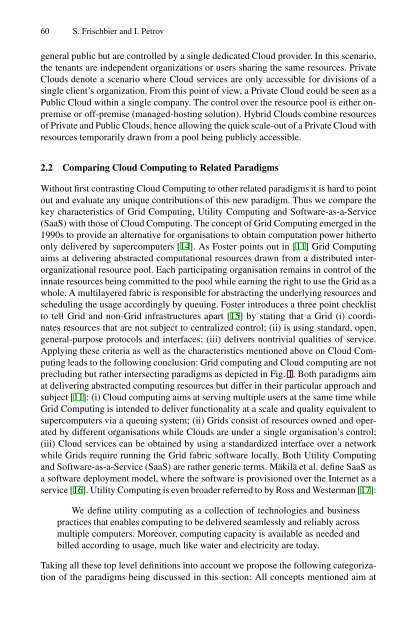Aspects of Data-Intensive Cloud Computing - DVS - Technische ...
Aspects of Data-Intensive Cloud Computing - DVS - Technische ...
Aspects of Data-Intensive Cloud Computing - DVS - Technische ...
Create successful ePaper yourself
Turn your PDF publications into a flip-book with our unique Google optimized e-Paper software.
60 S. Frischbier and I. Petrov<br />
general public but are controlled by a single dedicated <strong>Cloud</strong> provider. In this scenario,<br />
the tenants are independent organizations or users sharing the same resources. Private<br />
<strong>Cloud</strong>s denote a scenario where <strong>Cloud</strong> services are only accessible for divisions <strong>of</strong> a<br />
single client’s organization. From this point <strong>of</strong> view, a Private <strong>Cloud</strong> could be seen as a<br />
Public <strong>Cloud</strong> within a single company. The control over the resource pool is either onpremise<br />
or <strong>of</strong>f-premise (managed-hosting solution). Hybrid <strong>Cloud</strong>s combine resources<br />
<strong>of</strong> Private and Public <strong>Cloud</strong>s, hence allowing the quick scale-out <strong>of</strong> a Private <strong>Cloud</strong> with<br />
resources temporarily drawn from a pool being publicly accessible.<br />
2.2 Comparing <strong>Cloud</strong> <strong>Computing</strong> to Related Paradigms<br />
Without first contrasting <strong>Cloud</strong> <strong>Computing</strong> to other related paradigms it is hard to point<br />
out and evaluate any unique contributions <strong>of</strong> this new paradigm. Thus we compare the<br />
key characteristics <strong>of</strong> Grid <strong>Computing</strong>, Utility <strong>Computing</strong> and S<strong>of</strong>tware-as-a-Service<br />
(SaaS) with those <strong>of</strong> <strong>Cloud</strong> <strong>Computing</strong>. The concept <strong>of</strong> Grid <strong>Computing</strong> emerged in the<br />
1990s to provide an alternative for organisations to obtain computation power hitherto<br />
only delivered by supercomputers [14]. As Foster points out in [11] Grid <strong>Computing</strong><br />
aims at delivering abstracted computational resources drawn from a distributed interorganizational<br />
resource pool. Each participating organisation remains in control <strong>of</strong> the<br />
innate resources being committed to the pool while earning the right to use the Grid as a<br />
whole. A multilayered fabric is responsible for abstracting the underlying resources and<br />
scheduling the usage accordingly by queuing. Foster introduces a three point checklist<br />
to tell Grid and non-Grid infrastructures apart [15] by stating that a Grid (i) coordinates<br />
resources that are not subject to centralized control; (ii) is using standard, open,<br />
general-purpose protocols and interfaces; (iii) delivers nontrivial qualities <strong>of</strong> service.<br />
Applying these criteria as well as the characteristics mentioned above on <strong>Cloud</strong> <strong>Computing</strong><br />
leads to the following conclusion: Grid computing and <strong>Cloud</strong> computing are not<br />
precluding but rather intersecting paradigms as depicted in Fig. 1. Both paradigms aim<br />
at delivering abstracted computing resources but differ in their particular approach and<br />
subject [11]: (i) <strong>Cloud</strong> computing aims at serving multiple users at the same time while<br />
Grid <strong>Computing</strong> is intended to deliver functionality at a scale and quality equivalent to<br />
supercomputers via a queuing system; (ii) Grids consist <strong>of</strong> resources owned and operated<br />
by different organisations while <strong>Cloud</strong>s are under a single organisation’s control;<br />
(iii) <strong>Cloud</strong> services can be obtained by using a standardized interface over a network<br />
while Grids require running the Grid fabric s<strong>of</strong>tware locally. Both Utility <strong>Computing</strong><br />
and S<strong>of</strong>tware-as-a-Service (SaaS) are rather generic terms. Mäkilä et al. define SaaS as<br />
a s<strong>of</strong>tware deployment model, where the s<strong>of</strong>tware is provisioned over the Internet as a<br />
service [16]. Utility <strong>Computing</strong> is even broader referred to by Ross and Westerman [17]:<br />
We define utility computing as a collection <strong>of</strong> technologies and business<br />
practices that enables computing to be delivered seamlessly and reliably across<br />
multiple computers. Moreover, computing capacity is available as needed and<br />
billed according to usage, much like water and electricity are today.<br />
Taking all these top level definitions into account we propose the following categorization<br />
<strong>of</strong> the paradigms being discussed in this section: All concepts mentioned aim at















